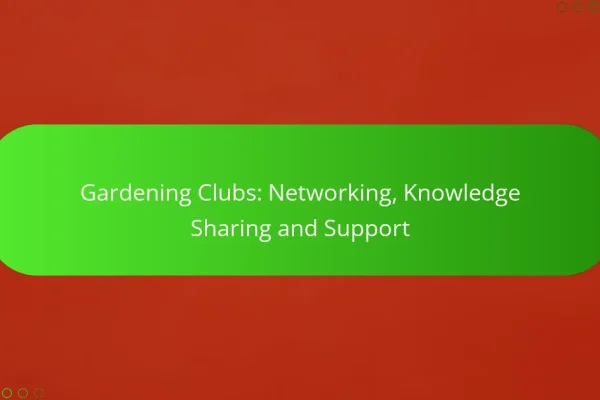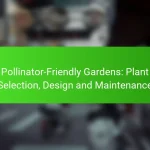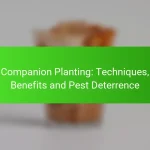How can community gardening benefit South African neighborhoods?
Community gardening can significantly enhance South African neighborhoods by improving food access, building social ties, and promoting local ecosystems. These gardens serve as vital resources for fresh produce and foster a sense of community among residents.
Improves local food security
Community gardens directly contribute to local food security by providing fresh fruits and vegetables to residents. This is particularly important in areas where access to grocery stores may be limited or where food prices are high.
By growing their own food, community members can reduce reliance on commercial food sources, which may be less affordable. Additionally, these gardens can help mitigate the impact of food shortages, especially during economic downturns.
Fosters social connections
Community gardening fosters social connections by bringing people together around a shared goal. Participants often collaborate on planting, maintenance, and harvesting, which builds relationships and strengthens community bonds.
These gardens can serve as social hubs, where individuals from diverse backgrounds come together, share knowledge, and support one another. This sense of belonging can enhance overall community well-being and resilience.
Enhances urban biodiversity
Community gardens play a crucial role in enhancing urban biodiversity by providing habitats for various species. These green spaces can attract pollinators like bees and butterflies, which are essential for healthy ecosystems.
By incorporating a variety of plants, community gardens can contribute to the overall health of the urban environment. They can also serve as educational platforms, teaching residents about native species and sustainable gardening practices.
What educational resources are available for gardeners in South Africa?
South Africa offers a variety of educational resources for gardeners, including online courses, local workshops, and community gardening clubs. These resources cater to different skill levels and interests, making gardening accessible to everyone.
Online gardening courses
Online gardening courses provide flexible learning options for individuals at any experience level. Platforms like Udemy and Coursera offer courses that cover topics from basic gardening techniques to advanced permaculture practices.
Many of these courses are affordable, often ranging from a few hundred to a couple of thousand South African Rand. Look for courses that include practical assignments or community forums for better engagement.
Local workshops and seminars
Local workshops and seminars are excellent for hands-on learning and networking with fellow gardeners. Organizations such as the South African Gardening Club frequently host events that focus on specific gardening techniques, seasonal planting, and pest management.
These workshops typically charge a nominal fee, often between R50 and R200, making them accessible to most. Check local community centers or gardening stores for schedules and registration details.
Community gardening clubs
Joining a community gardening club is a great way to learn from experienced gardeners while contributing to local green spaces. Clubs often organize regular meetings, garden tours, and collaborative projects that enhance practical skills.
Membership fees are usually low, often under R100 per year, and provide access to shared resources, tools, and knowledge. Engaging with a community can also foster friendships and support networks among gardeners.
How to start a community garden in South Africa?
Starting a community garden in South Africa involves organizing local residents, selecting a suitable site, and navigating any necessary regulations. Engaging the community and ensuring everyone is on board is crucial for success.
Identify a suitable location
Choosing the right location for a community garden is essential. Look for areas with good sunlight, access to water, and soil that can support plant growth. Community parks, vacant lots, or school yards can be ideal spots.
Consider the proximity to community members to encourage participation. A location within walking distance for most residents will likely attract more volunteers and participants.
Gather community support
Building community support is vital for the garden’s sustainability. Start by hosting meetings to discuss the idea and gather input from local residents. Use social media, flyers, and word of mouth to reach a wider audience.
Engage local organizations, schools, and businesses to foster partnerships. Their involvement can provide resources, funding, or volunteers, enhancing the garden’s impact and reach.
Obtain necessary permits
Before starting a community garden, check with local authorities to understand any permits or regulations that may apply. In South Africa, this may include zoning laws or land use regulations that dictate where gardens can be established.
Contact your local municipality for guidance on the application process. Having the right permits ensures that the garden operates legally and can prevent future disputes or issues with land use.
What are the best practices for sustainable gardening?
The best practices for sustainable gardening focus on minimizing environmental impact while promoting healthy ecosystems. Key strategies include using organic methods, conserving water, and encouraging native plant species.
Use organic gardening methods
Organic gardening methods prioritize natural processes and materials over synthetic chemicals. This includes using compost, natural fertilizers, and pest control methods such as beneficial insects or organic sprays.
To implement organic practices, start by enriching your soil with compost and mulching to retain moisture. Avoid chemical pesticides and herbicides, opting instead for natural alternatives that are less harmful to the environment.
Implement water conservation techniques
Water conservation techniques are essential for sustainable gardening, especially in areas prone to drought. Techniques such as drip irrigation, rainwater harvesting, and using mulch can significantly reduce water usage.
Consider installing a rain barrel to collect runoff from your roof, which can be used to water your garden. Additionally, group plants with similar water needs together to optimize irrigation efficiency.
Encourage native plant species
Encouraging native plant species is crucial for supporting local wildlife and maintaining biodiversity. Native plants are adapted to the local climate and soil conditions, requiring less water and care than non-native varieties.
To promote native species, research plants that thrive in your region and incorporate them into your garden. This not only helps local ecosystems but also reduces the need for fertilizers and pesticides, creating a more sustainable garden environment.
How can schools incorporate gardening into their curriculum?
Schools can incorporate gardening into their curriculum by integrating hands-on projects, science lessons, and environmental education. These activities not only enhance students’ learning experiences but also promote teamwork and responsibility.
Hands-on gardening projects
Hands-on gardening projects allow students to engage directly with nature and learn practical skills. Schools can set up small gardens on campus where students can plant, maintain, and harvest crops, fostering a sense of ownership and accomplishment.
Consider organizing seasonal planting events or garden clubs that encourage participation from all grade levels. These projects can be tailored to fit various subjects, making learning more dynamic and interactive.
Science and biology lessons
Gardening provides an excellent platform for science and biology lessons, allowing students to explore plant biology, ecosystems, and sustainability. Teachers can incorporate lessons on photosynthesis, soil health, and the life cycles of plants, making complex concepts tangible.
Field trips to local farms or botanical gardens can further enhance these lessons, providing real-world context and inspiration. Students can also conduct experiments, such as testing soil pH or observing plant growth under different conditions.
Environmental education programs
Environmental education programs can benefit greatly from gardening initiatives, as they teach students about biodiversity, conservation, and the importance of local ecosystems. Schools can create programs that focus on sustainable gardening practices, such as composting and organic farming.
Incorporating community service projects, like planting trees or maintaining local parks, can also enhance students’ understanding of their environmental impact. Collaborating with local environmental organizations can provide additional resources and expertise, enriching the educational experience.
What are the challenges of community gardening?
Community gardening faces several challenges that can hinder its success, including access to land, funding, and community engagement. Addressing these issues is crucial for creating sustainable and thriving gardening initiatives.
Access to land
Securing land for community gardening is often the most significant hurdle. Many urban areas have limited available space, and land ownership can complicate access. Community groups may need to negotiate with local governments or private landowners to obtain permissions or leases.
In some regions, community gardens can be established on vacant lots or underutilized public spaces. It’s essential to research local zoning laws and land use regulations to identify suitable locations for gardening projects.
Funding and resources
Funding is critical for community gardening initiatives, as it covers costs like seeds, tools, and maintenance. Many community gardens rely on grants, donations, or fundraising events to secure necessary resources. Establishing a clear budget and identifying potential funding sources early on can help sustain the garden.
Additionally, forming partnerships with local businesses or organizations can provide both financial support and in-kind donations, such as soil or gardening supplies. Engaging the community in fundraising efforts can also foster a sense of ownership and commitment to the garden.
Community engagement
Active community engagement is vital for the success of a community garden. Without participation from local residents, gardens can struggle to thrive. Organizing regular meetings, workshops, and social events can help build a sense of community and encourage involvement.
It’s important to create an inclusive environment where everyone feels welcome to contribute. Establishing clear roles and responsibilities among participants can also enhance collaboration and ensure that the garden meets the needs of its members.











